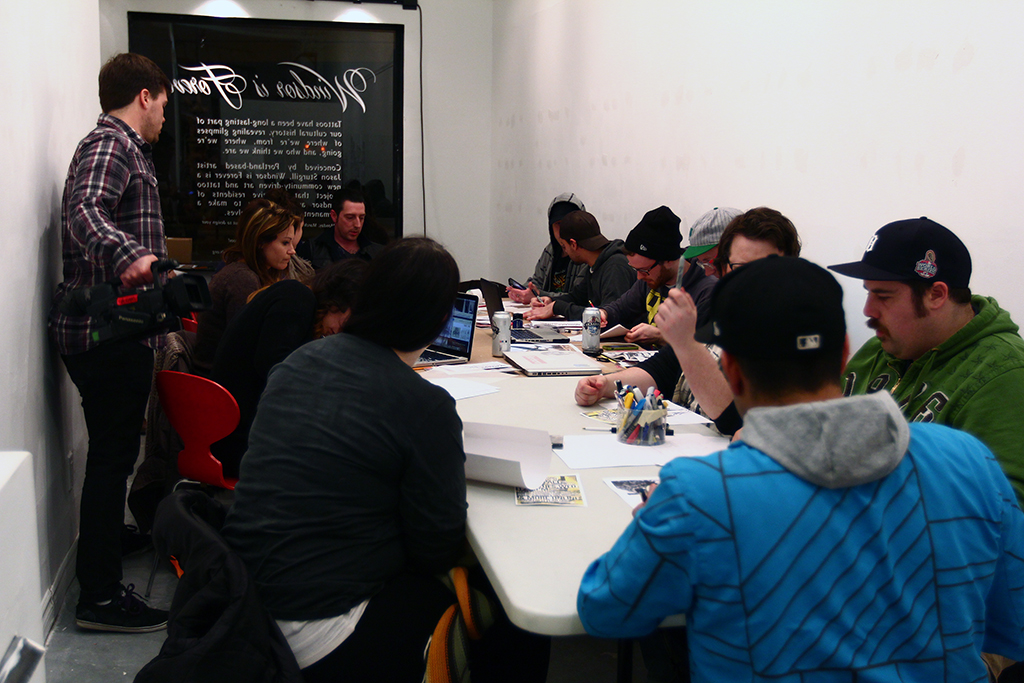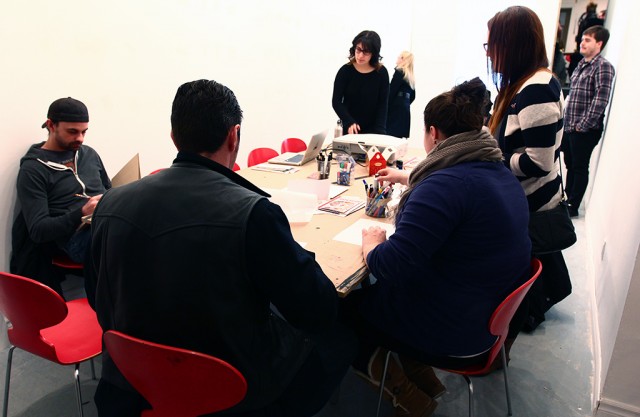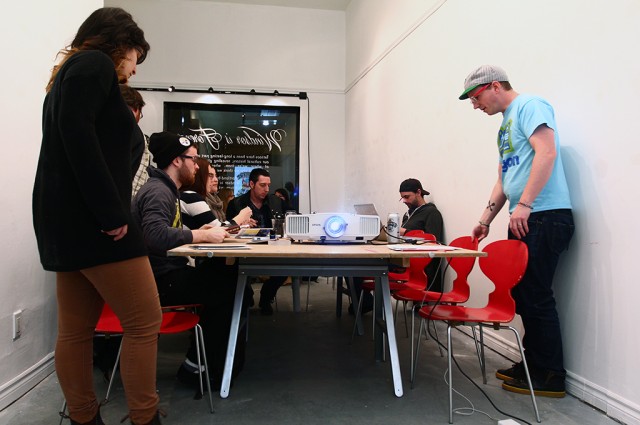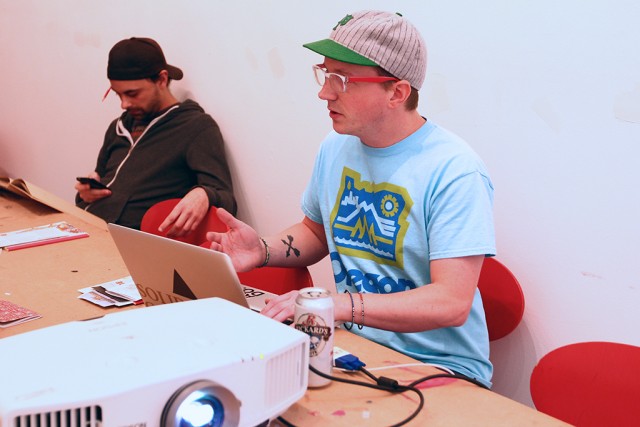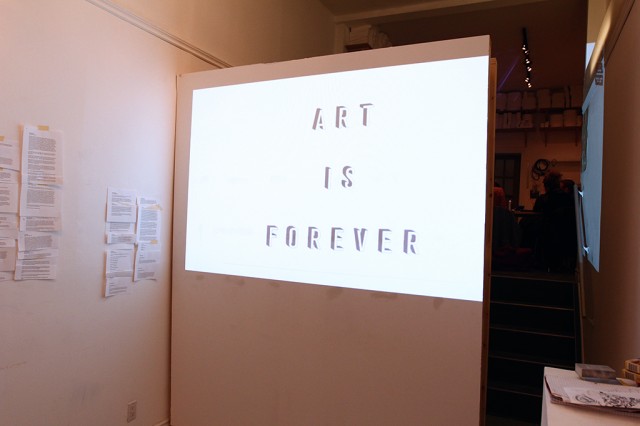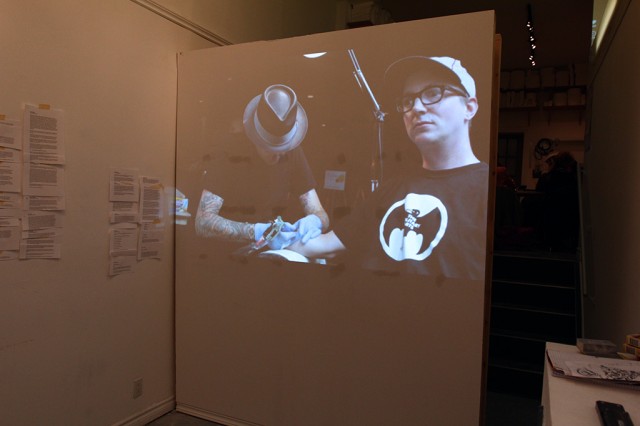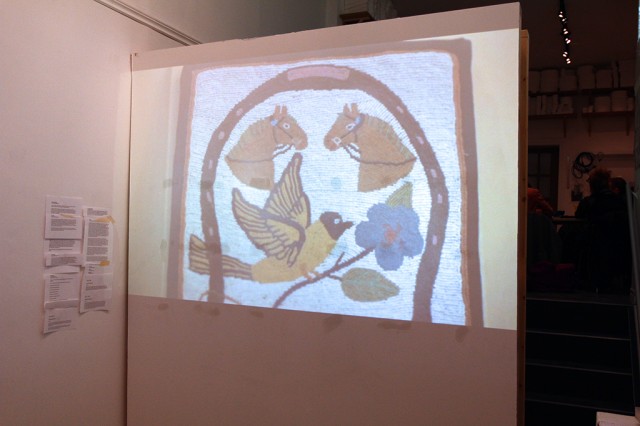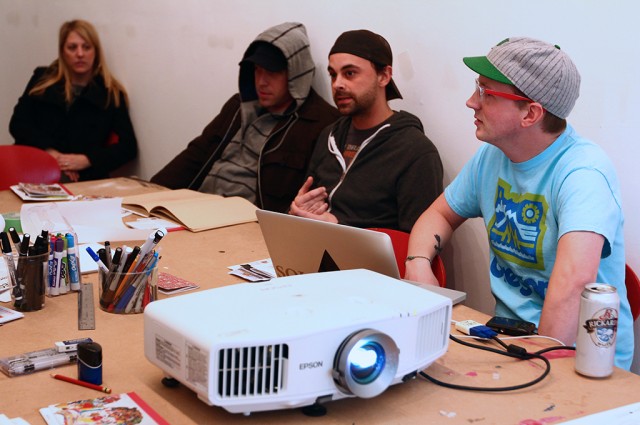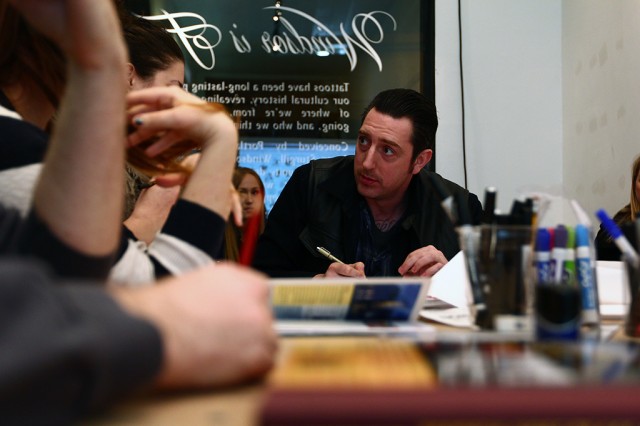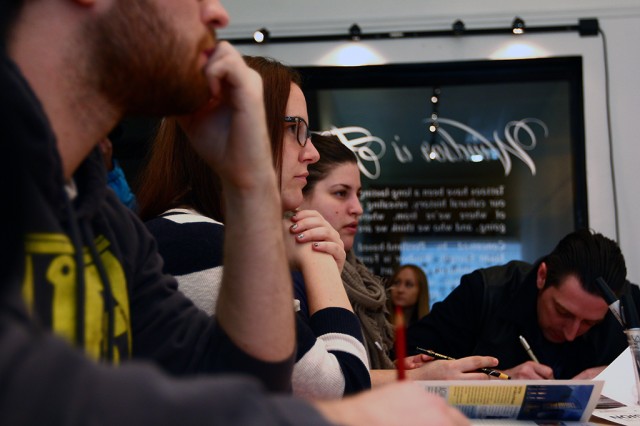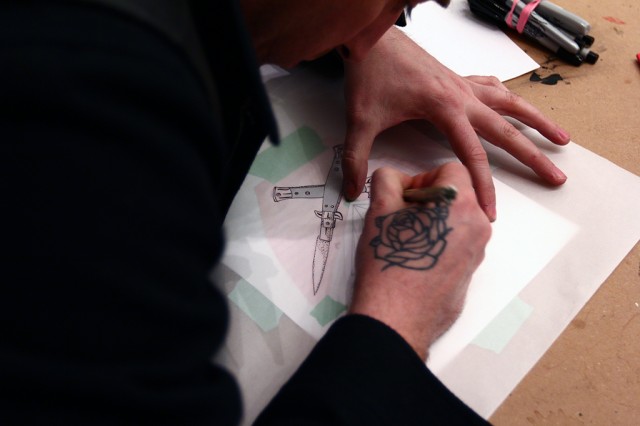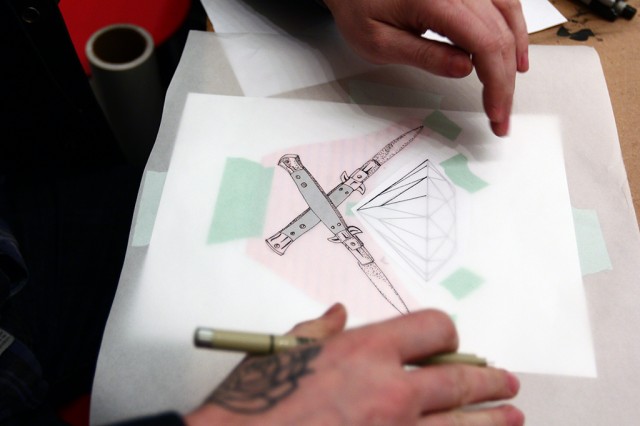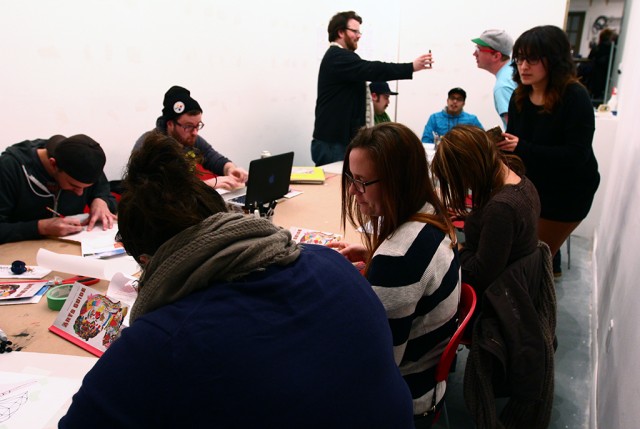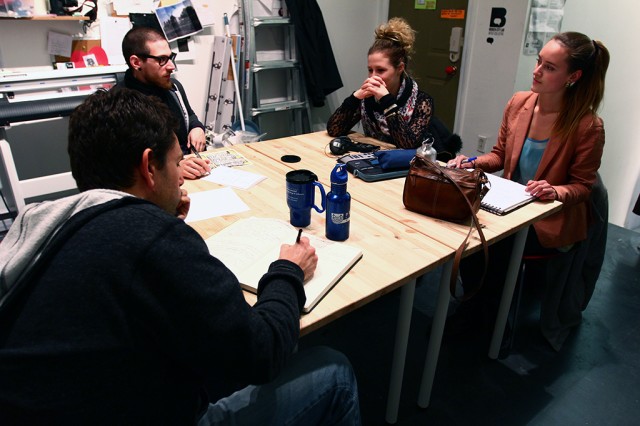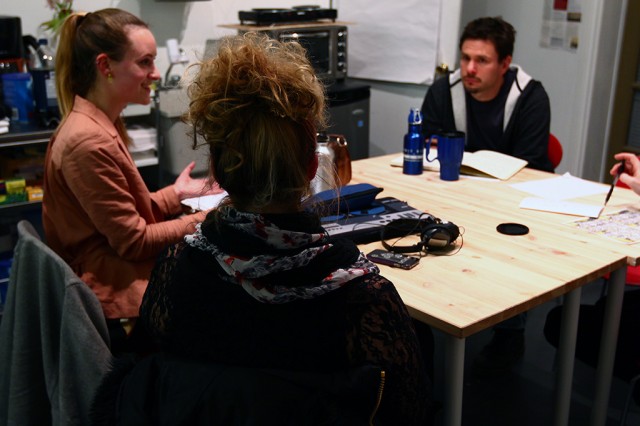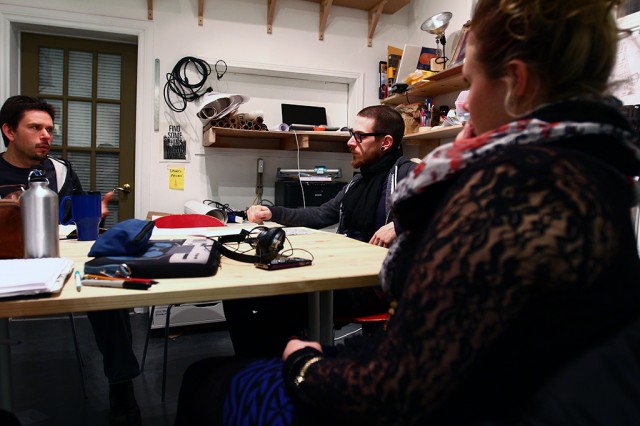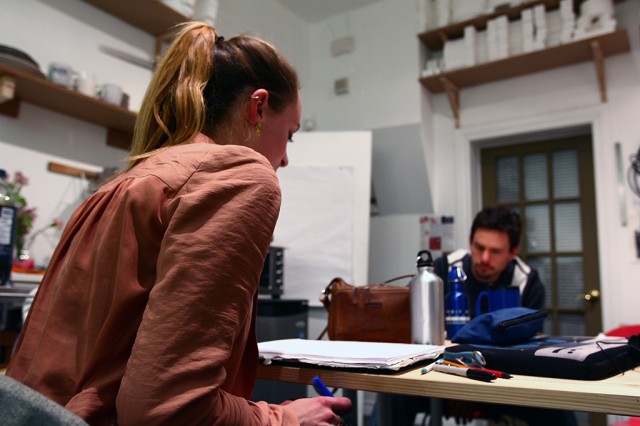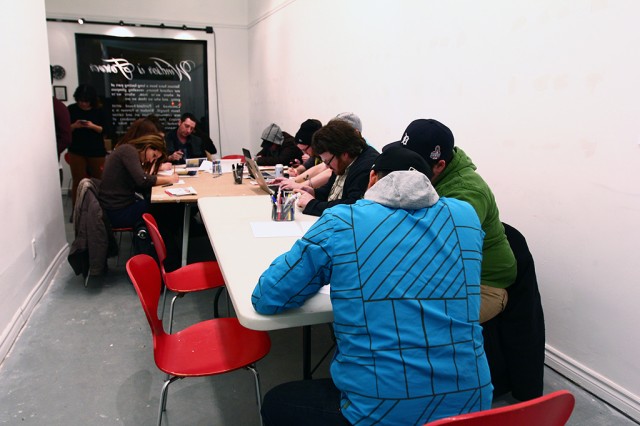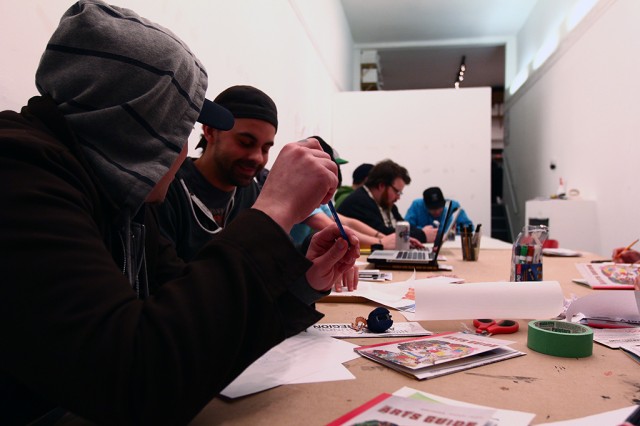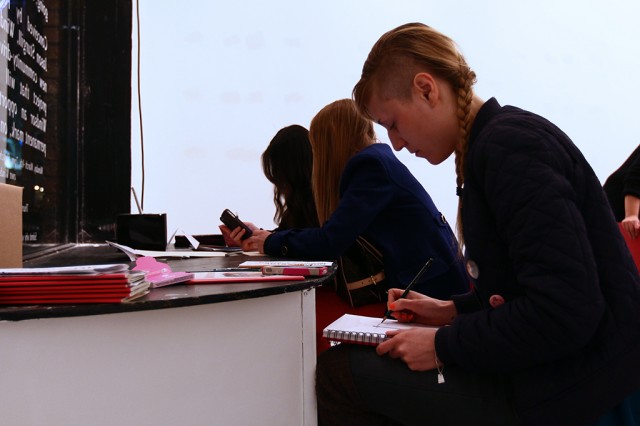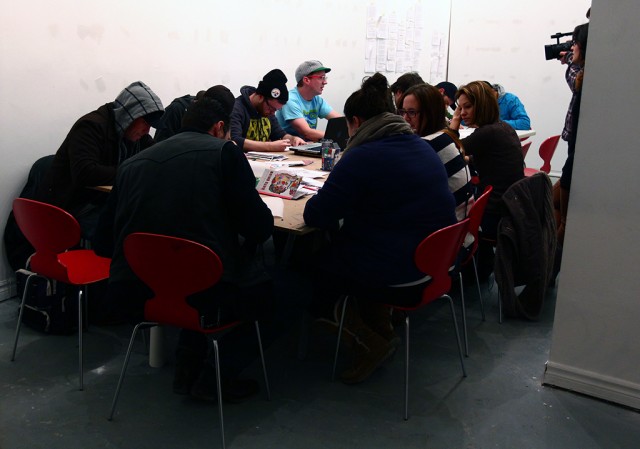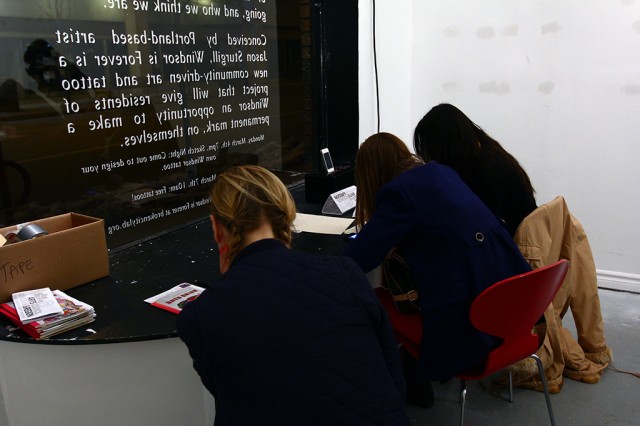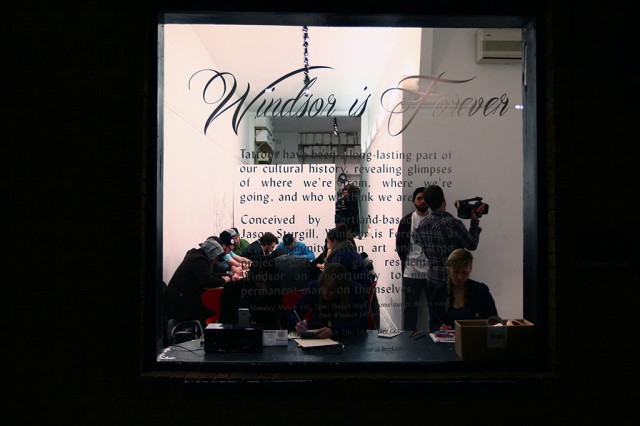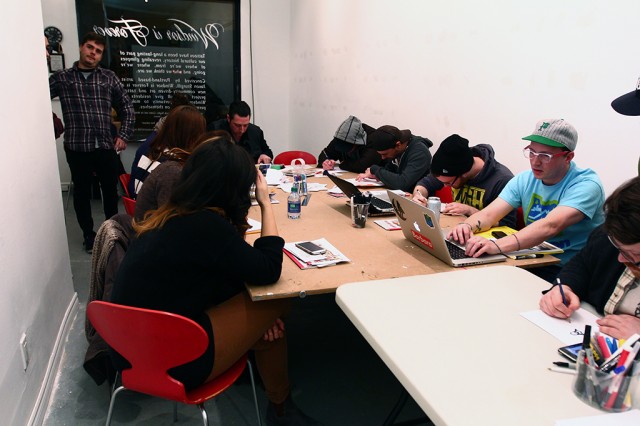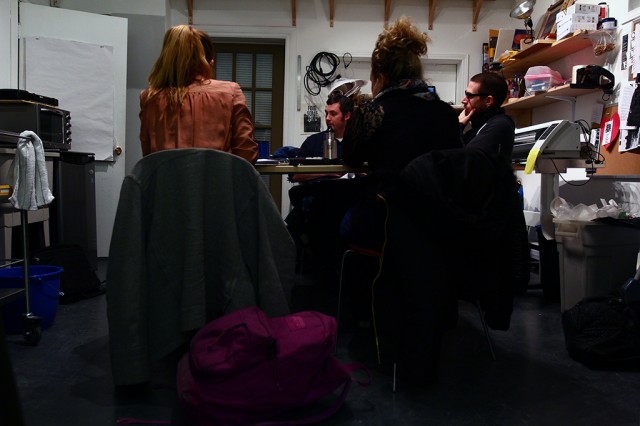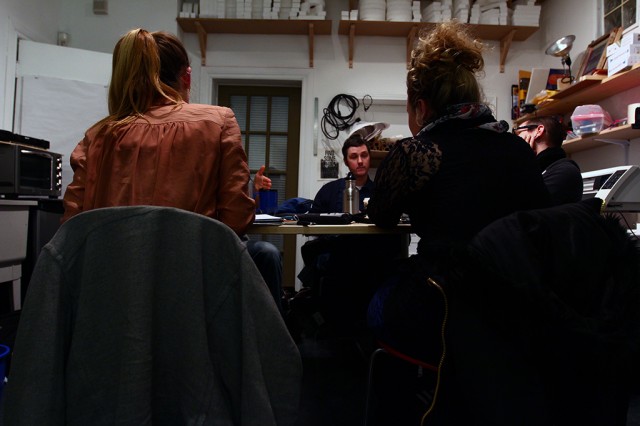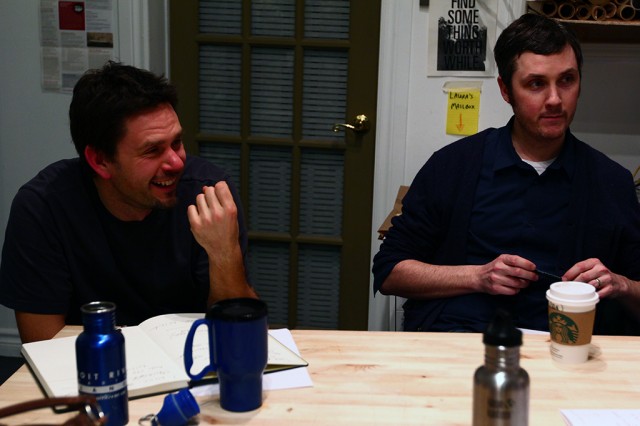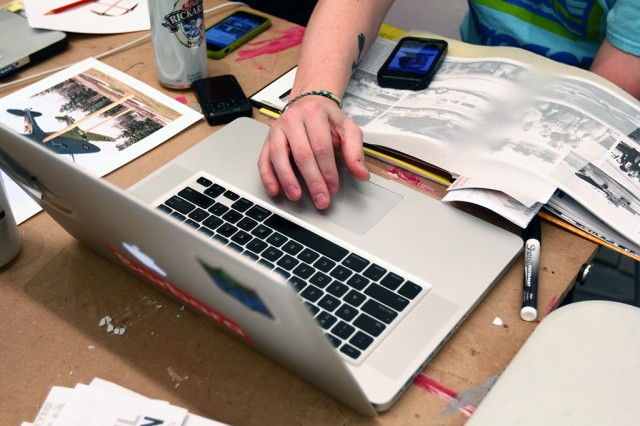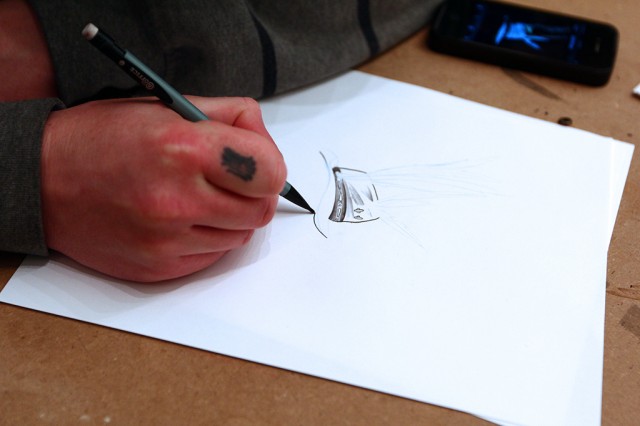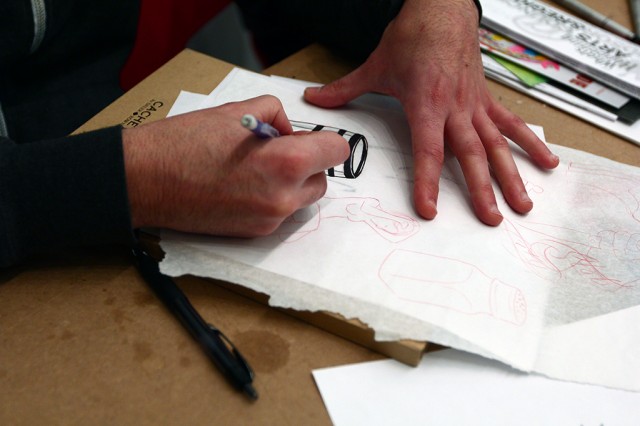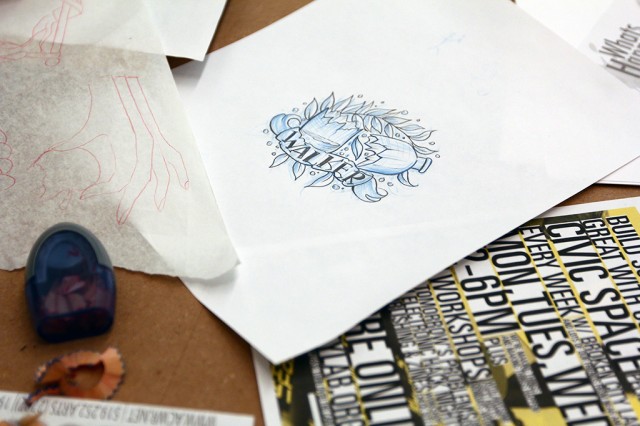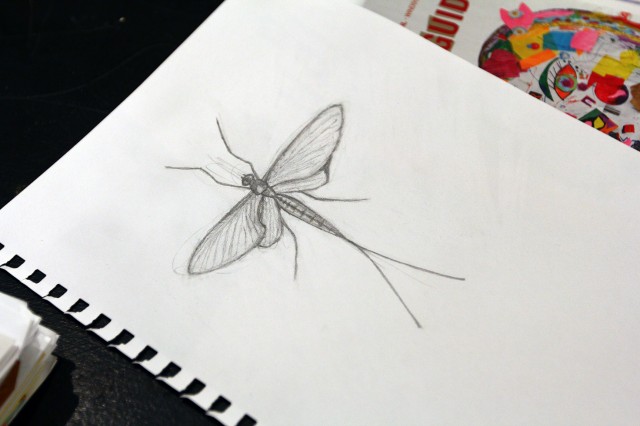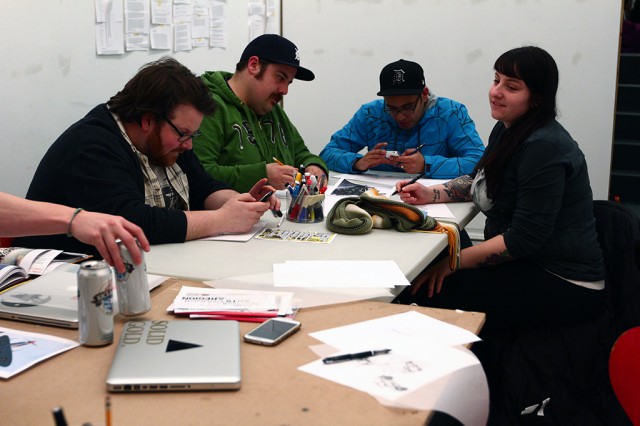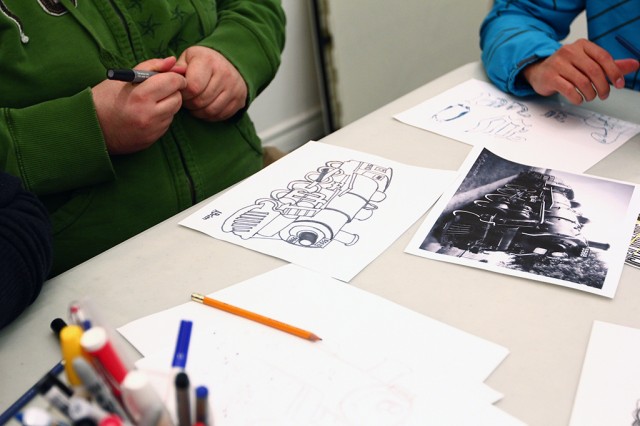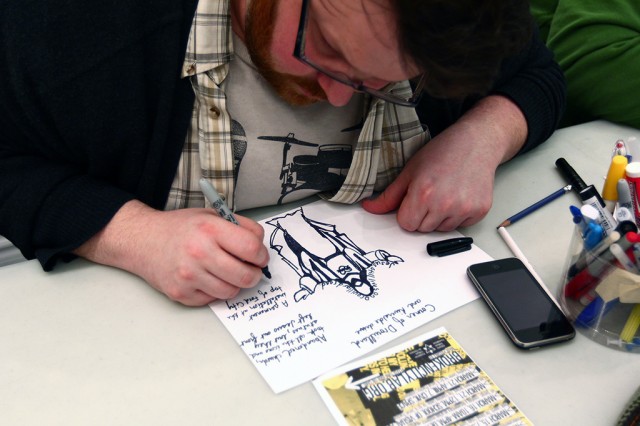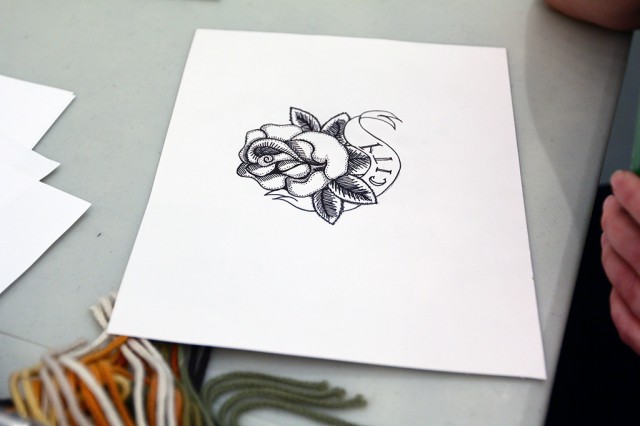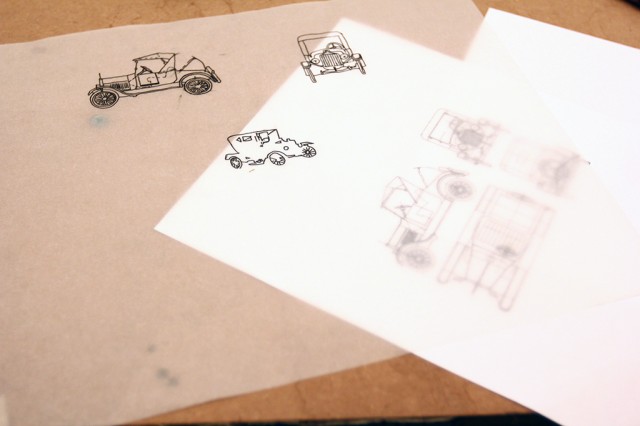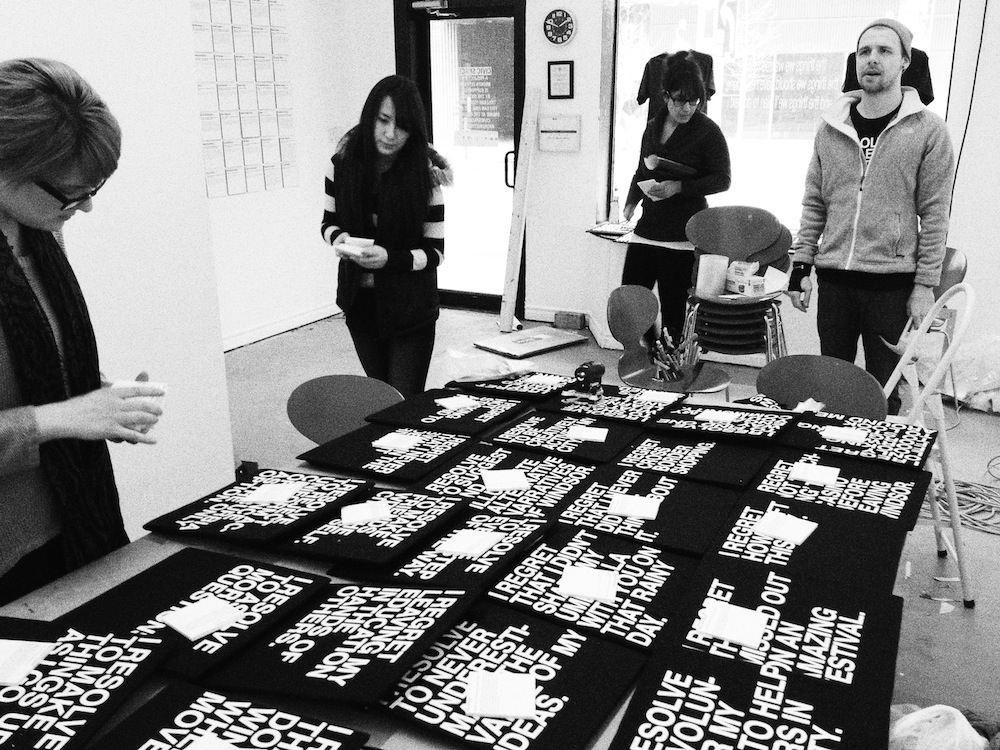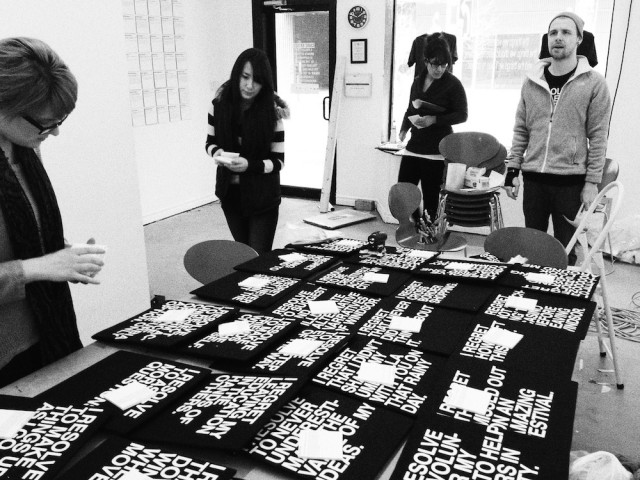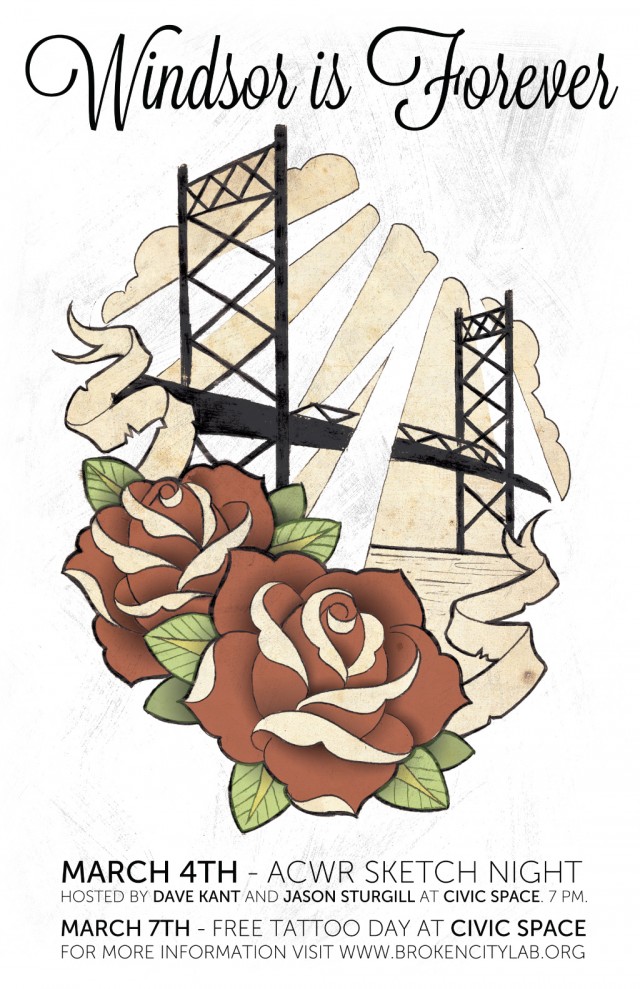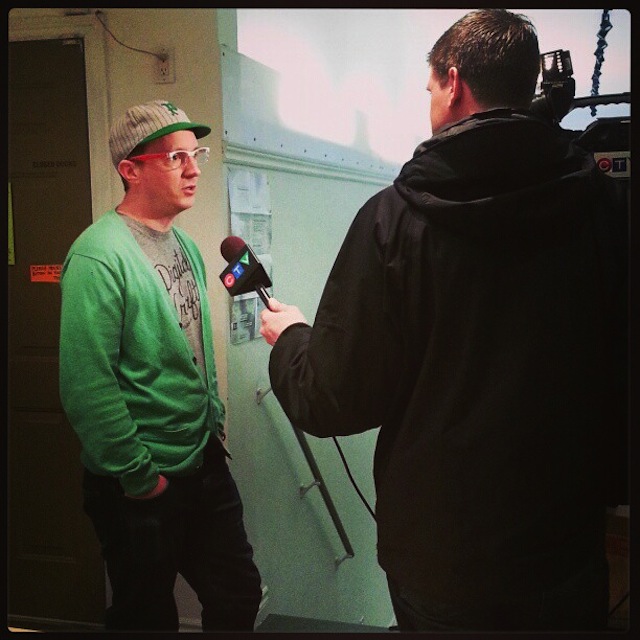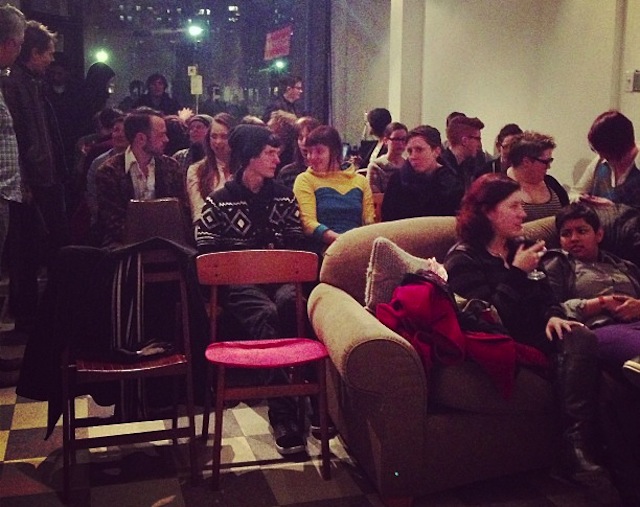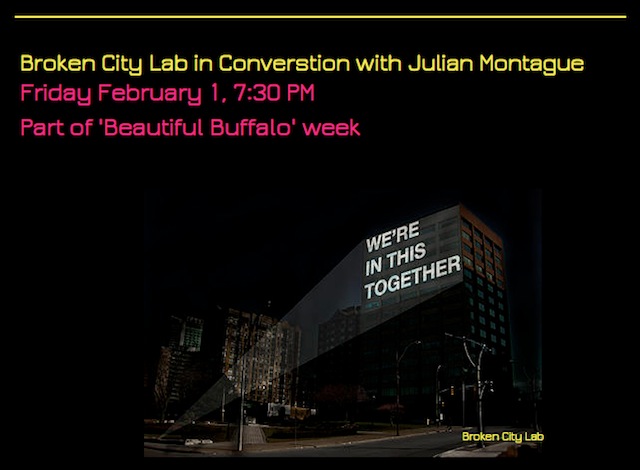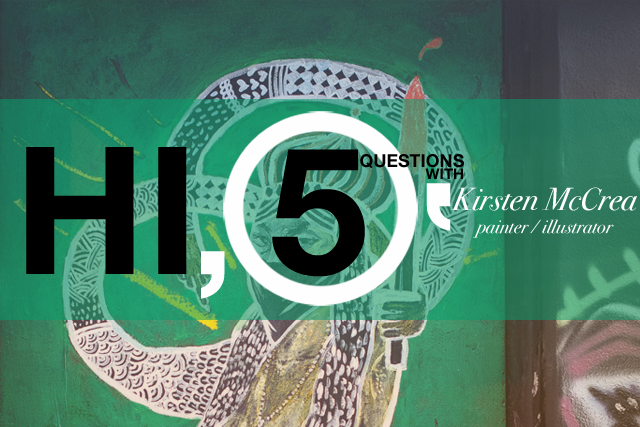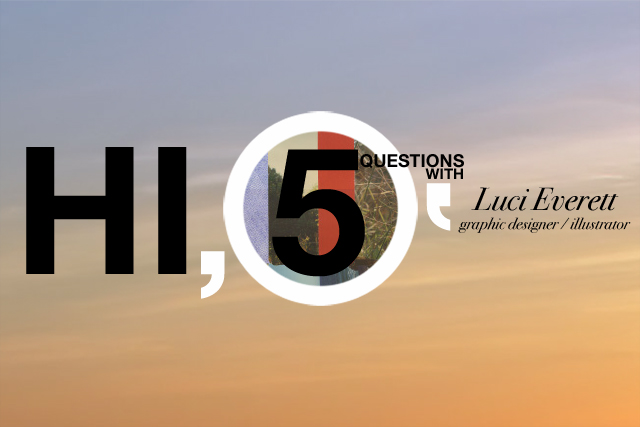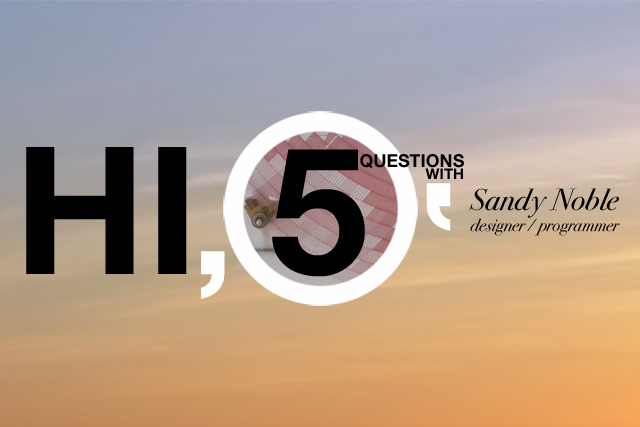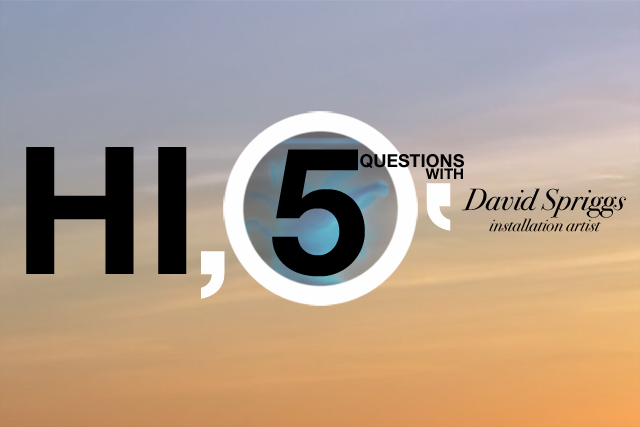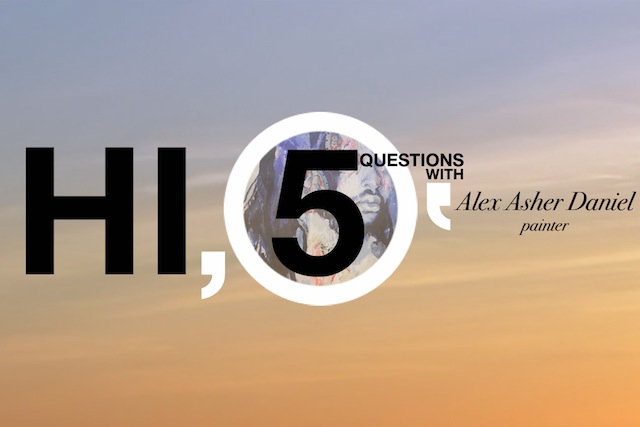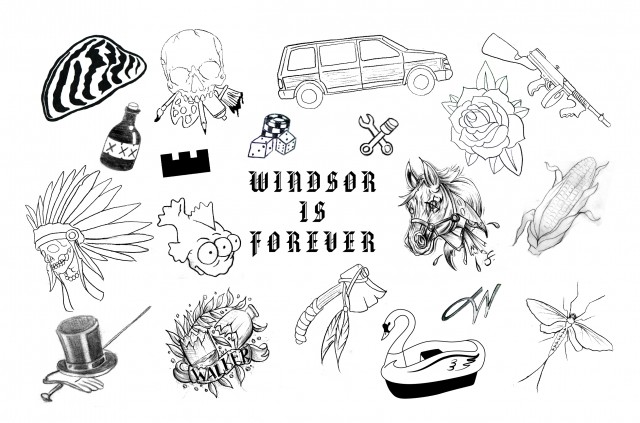 Here it is, the Windsor is Forever tattoo flash set (in two parts). With the help of those who came out on Monday’s Sketch Night, Jason Sturgill has whittled down the submissions to the most poignant designs and optimized them for our free tattoo day tomorrow. If you submitted a story and were contacted to book an appointment, we’ll see you tomorrow!
Here it is, the Windsor is Forever tattoo flash set (in two parts). With the help of those who came out on Monday’s Sketch Night, Jason Sturgill has whittled down the submissions to the most poignant designs and optimized them for our free tattoo day tomorrow. If you submitted a story and were contacted to book an appointment, we’ll see you tomorrow! 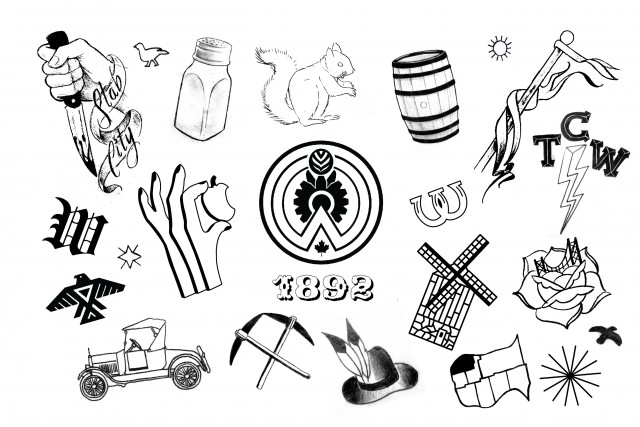
Monday Night at Civic Space: Tattoo Sketch Night and ATP
Last night we held two events in Civic Space at once. On the main level, we held a Tattoo Sketch Night with Jason Sturgill and Dave Kant, in partnership with Arts Council Windsor & Region and leading up to Windsor is Forever. Upstairs we held All Tomorrow’s Problems, a weekly design night hosted by Dan McCafferty and Veronica Samek. Keep next Monday, March 11th in your calendars because at All Tomorrow’s problems, we’ll be working with letraset.
Our Sketch Night was intended to give those interested in Windsor the time, space, and environment to sketch, think, and discuss what Windsor might look like as a tattoo. We spent most of the night researching Windsor imagery from the past and discussing what is iconic in the present. The designs that were made will be refined and used in a flash set for the Free Tattoo Day we’re hosting on Thursday, March 7th. If you submitted a story to our online form before yesterday, you should be hearing from us shortly!
Once everyone started trickling into the space, we had them grab a set at our big table.
Jason then introduced himself and showed a quick video clip of the project he did in Portland called Art is Forever. This is a loose model for our project Windsor is Forever.
Dave Kant of Advanced Tattoo in Windsor then discusses his role in the project and what visitors will be doing for the evening.
Brainstorming involved quite a lot of discussion last night. Most people bounced ideas off of each other before coming up with an idea.
Participants brought a variety of materials to the event, such as tracing paper, previous sketches, and printouts.
Meanwhile, All Tomorrow’s Problems was starting upstairs.
It was a cozy group, but the conversation was on point and the energy level was high.
About a half hour later, we had to bring another table out for another group who showed up. Thanks to ACWR, we had two folding tables at our disposal.
Dave and Steve, two of the tattoo artists who will be working on Thursday to make these designs a little more permanent, worked fiercely to come up with pages of designs.
Some sat by the window and used the ledge as a drawing surface.
After more than an hour, it was clear that people were connecting with their designs.
A few people brought laptops and used them to do visual research on the fly.
Back upstairs, conversations ensued during Monday night’s All Tomorrow’s Problems (ATP) design night.
Most people brought notebooks to All Tomorrow’s Problems and either referenced past meetings or added new points of discussion.
Jason was equipped with books and his laptop to inspire his designs. He will probably be using a mix of digital and traditional design tools.
One of the most deeply-rooted design ideas was Steve’s rendition of the “feather hat”.
Dave creates a sheet of designs inspired by our economy and details of the past.
Here is a drawing of a local insect done in graphite, the Mayfly.
This participant brought a large locomotive photo to reference for his design.
The rose creeped into a couple of the designs. Most would consider them to be highly symbolic of Windsor.
Lastly, we have a line drawing of an early automobile. It’s no secret that Windsor is an automotive city, so this design might be a popular choice.
Thanks to everyone who came out and had fun contributing to the Windsor design flash set and chatting about Windsor! Keep an eye on our blog for more developments on Windsor is Forever.
New CIVIC Space Open Hours, Sketch Night, and Meet Jason Sturgill
Starting this week, March 4, we’ll be open every Monday, Tuesday, and Wednesday from 12pm – 6pm! These hours will continue into the spring, so come by and hang out with us. Also coming up this week:
MONDAY, MARCH 4th – ACWR Sketch Night with Jason Sturgill and Dave Kant
All are welcome to attend and sketch alongside Portland’s Jason Sturgill and Windsor tattoo artist Dave Kant. The goal of the night is to explore Windsor imagery and create the flash sets for the upcoming free tattoo event Windsor is Forever, happening on Thursday, March 7 at CIVIC Space (411 Pelissier). This event is part of Arts Council Windsor & Region‘s Sketch Night Series.
TUESDAY, MARCH 5th – Meet Jason Sturgill
Residents are encouraged to come and meet Jason Sturgill in person from 12pm-6pm on Tuesday, March 5th at CIVIC Space (411 Pelissier). Jason is interested in hearing about your favourite places, objects, and people in this great city!
Broken City Lab and Julian Montague at Videofag
On behalf of everyone at Broken City Lab, Cristina Naccarato and I would like to send a big thanks to Toronto’s Videofag for hosting a discussion between us and Buffalo artist Julian Montague on Friday. Though brief, the discussion allowed the three of us to elaborate on the cities in which we work, how they influence us, and what types of opportunities they provide for artists and other creative folk. Julian likened Buffalo to Detroit; both cities had a boom and bust this century and as a consequence, both have massive properties that can be purchased at insanely cheap prices.
Though our works were quite different, we were still able to speak about similar topics at once. We would like to pick up where we left off with Julian, and potentially find our way to Buffalo for a visit (or unforeseen project). Thanks to all involved and everyone who came out despite the chilly weather!
Photo by Cristina Naccarato
Broken City Lab in Conversation with Julian Montague at Videofag
Friday, February 1st, 7:30pm – 187 Augusta Avenue, Toronto, Ontario
This Friday, Cristina Naccarato and Joshua Babcock of Broken City Lab will be heading to Toronto to participate in a discussion at Videofag with Julian Montague. The discussion will revolve around the repurposing of space in “North American Rustbelt Cities”. Julian will be discussing the topic from an American perspective while Joshua and Cristina will be discussing their work in Southwestern Ontario, Canada.
Julian Montague is a Bufflo-based artist whose work frequently draws upon the socio-political ecologies and aesthetics of the American Rustbelt. His acclaimed projects include ‘The Ruins of 270 Sherman Ave North’, ‘The Shopping Carts of Eastern North America’, and ‘Abandoned House Project’.
“Videofag is excited to be hosting these three artists in discussion on the ways in which artists cities with an abundance of space – specifically in so-called ‘North American Rustbelt’ – are innovating new functions for disused buildings/public spaces, and in the process reinventing the possibilities of neighbourhoods, community, and the artist’s role within a city. Specific examples will be drawn from BCL’s own repurposing of Windsor storefronts and empty ad space on city transit.”
Hi, 5 with Kirsten McCrea
About the Hi, 5 Interview Series
Hi, 5 (5 Questions) is a web-only interview series which presents five questions to artists, activists, and creative thinkers alike. The project acts as an educational device which allows us to gain insight into the narratives that define successful individuals. We are interested in the motivations behind ambitious ideas and how these individuals chart personal change in relation to their surroundings.
About Kirsten McCrea
Kirsten McCrea is a Canadian artist whose work explores issues of cultural memory, looking at pop vs. underground culture, the media, and popular mythologies. Known for her bright colours and figurative subject-matter, Kirsten is quickly establishing herself as a prominent emerging Canadian artist. Primarily a painter, she is also the founder and editor of Papirmasse, an affordable art subscription that sends a monthly print to hundreds of people around the world every month.
Her paintings have been exhibited nationally and her work has been reviewed by The Walrus, Chatelaine, and The Montreal Gazette, amongst others. She has illustrated for the Polaris Music Prize & the Under Pressure Graffiti festival, and her patterned drawings can be found on notebooks and apparel in stores across the country. When not working on her own she collaborates with the art collective Cease and the drawing initiative En Masse, whose work was recently shown in the form of a massive installation in the Musée des Beaux Arts in Montreal. QC.
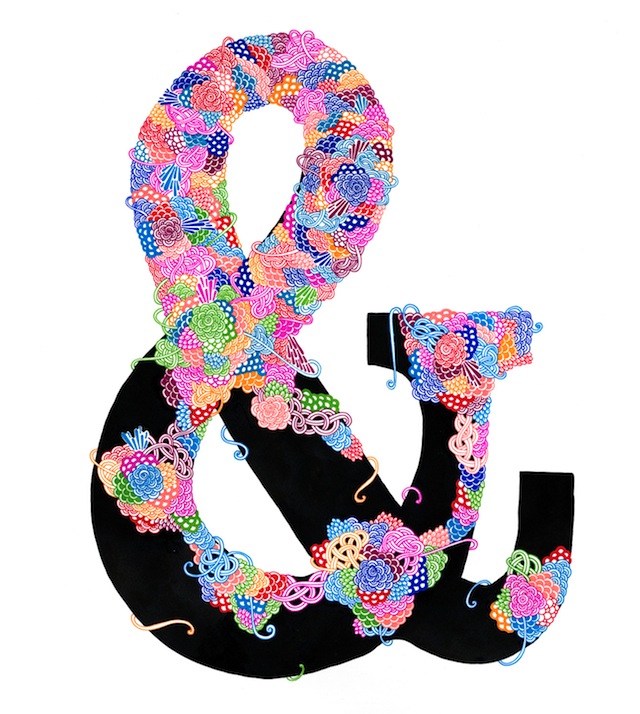
Kirsten McCrea
If you had to describe your current self to a 16-year-old you, what would you say?
Your parents and everyone you know are going to lie to you and say that nobody can really be an artist as their job. They won’t do it out of malice, but out of love and concern for your future. But you know what? They’ll all be wrong. You CAN be an artist full-time, and you will be. Also, in two years when you decide to grow dreadlocks – don’t. Just don’t. It’s not going to work out.
Could you describe an evolution in your work or way of thinking?
I feel like I have gone back and forth between conceptualism and aestheticism quite a bit. At one point I was a huge theory nerd, then I got really disenchanted with theory and fell in love with street art, which at its core is populist and just viscerally appealing (or sometimes viscerally enraging, depending on your take. Either way – it’s goal is to elicit an emotional reaction). Now I’m cozying up to concept again and am coming to appreciate art with big ideas behind it. But I still love aesthetics, and want to find a way in my practice to make work that is nice to look at but still makes you think. I think that it took a long time to realize that I could do both.
Are there any people who have been instrumental in the development of your way of thinking and viewing the world?
David Choe completely blew my mind wide open when I was 18. I was visiting Montreal (still living in Edmonton at the time, a city that is pretty isolated and not exactly a hotbed of radical anything) and found his book Bruised Fruit in (of all places) an Urban Outfitters. Having grown up in a city that has the highest number of chain stores per capita, I honestly thought that if something was in one bookstore it meant that it was in every single other bookstore. Sad, I know. It turns out that that book was a very limited run (and there were certainly no copies in Edmonton!), but my best friend tracked it down for me and even got him to sign it. Talk about the best birthday present ever! My copy is tattered because I have looked at it so much, and even though I’m not a huge fan of Choe’s work anymore (the sexism kills it for me), it was through him that I discovered Juxtapoz and an entire community of artists on the internet who became some of my biggest influences. I had never seen lowbrow before and discovering it was maybe the most exciting feeling of my life. It felt like I had finally found my home.
How do your political beliefs inform or fuel your work as an artist?
I am a very political person. I used to be very involved in activism, but now art takes all of my time (living in Montreal also made me complacent – it’s so good there compared to right-wing Alberta). Nonetheless, I think that my political beliefs are always present in my work. I try to really consider when I make an image what unconscious ideas are influencing it and how it will be perceived. Particularly in portraiture, I think that it is very easy for artists to fall into the trap of regurgitating the language of advertising. We see ads literally all day long – how can they not dictate your ideas about how a person should be portrayed and what kind of person should be portrayed?
I am currently working on a follow-up to my 2008 series Hot Topic, which is 60 paintings of feminist icons. In Hot Topic Redux I’ll paint another 20. Stay tuned to my website (www.hellokirsten.com) because I’ll be launching a site in the next month or so where I take viewer suggestions about which feminist icons should be painted next.
I also run Papirmasse, an affordable art subscription that sends a monthly print to people around the world for only $5 a month. I really think that people should not be shut out of the art world because of income, so I’m doing my part to make art more accessible and help it circulate through the world. People are afraid to have an opinion about art – they think they need an Art History degree to say whether they like something or not! With Papirmasse I always say – it’s yours now, it’s coming into your home. There’s no expert. YOU are the expert. You decide if you like it or not. And at 5 dollars don’t be too precious about it. If you like a part of it then cut it up and frame it. Make art work for you. Have a dialogue with it. The conversation doesn’t have to be a one-way street.
What do you feel a city should be or do for its inhabitants?
This is an interesting question for me at this time in my life, as I am transitioning from Montreal to Toronto (6 years after leaving my hometown of Edmonton). Toronto seems like a cool place with a really active populace who is interested in improving their city, but I have a sneaking suspicion that in some ways it won’t be able to match Montreal. The reason I love Montreal so much (and what enticed me away from Edmonton) is that it is a very actively lived-in city. The population seems to move through and interact with the space in a much more engaged way than, say, Edmonton, where you rarely see anyone out in the street and only see car after car.
This happens because of bike lanes, beautiful public parks, great public transportation, and lots of lots of free shows, festivals, and events. Montreal routinely shuts down entire busy streets for days (or even months!) at a time so that they can become pedestrian walkways. I think that they value the citizen more than cars or commerce. This seems counterintuitive because obviously citizens in a sense *are* cars and commerce. But it shows a different way of thinking about how we interact with our environments, and it shows that basic day-to-day experience is valued more than getting people to and from work fast. Does shutting down St. Catherines street for 4 months every summer make economic sense? Maybe not, in the traditional sense. But it has turned the Village into a thriving neighbourhood, and nothing really beats walking down a street full of people strung with lanterns and bustling energy. Those kinds of moments are what people who visit the city remember about Montreal, and it’s what makes me sad to leave it. I think that in North America there is a tendency to value making money as the most important factor in city-based decision-making, and what makes Montreal special is that it values happiness, culture, and human experience more.
I also think that a city should leave art (aka graffiti) up outside. Urban environments aren’t supposed to be clean showrooms. Cities are slates for multiple expressions, and street art ads to the feeling of being in a vibrant space that is alive.
Hi, 5 with Luci Everett
About the Hi, 5 Interview Series
Hi, 5 (5 Questions) is a web-only interview series which presents five questions to artists, activists, and creative thinkers alike. The project acts as an educational device which allows us to gain insight into the narratives that define successful individuals. We are interested in the motivations behind ambitious ideas and how these individuals chart personal change in relation to their surroundings.
About Luci Everett
Luci Everett is a graphic designer and illustrator living in Melbourne, Australia. She does a lot of paper cutting, painting and scanning.
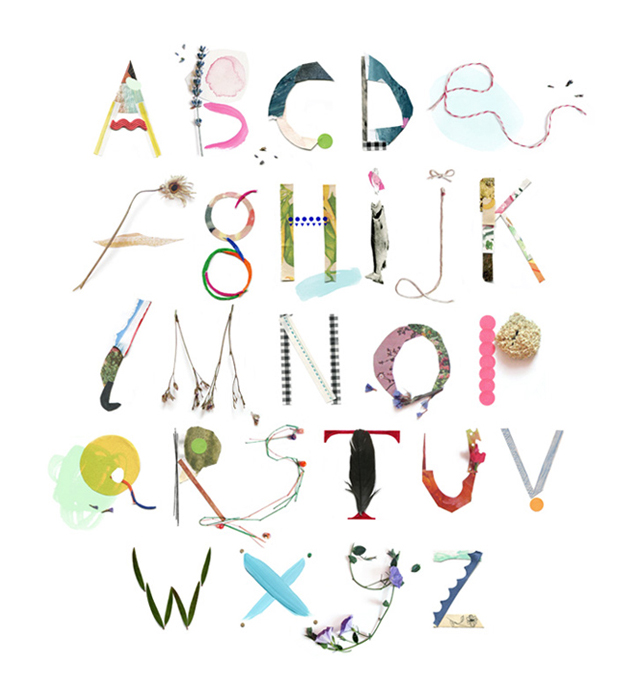
Luci Everett
If you had to describe your current self to a 16-year-old you, what would you say?
Relationships and friendships are much easier now. It’s not going to be sudden, but gradually you’ve become much more confident and comfortable with yourself. You pursued graphic design and have a lot of fun. Every year gets better.
Could you describe an evolution in your work or way of thinking?
I think I’ve developed a more discerning eye over the last few years. I have a slightly more practical approach to creative ideas than I did when I was studying design at university – I guess that comes with working on real projects. That said, I’m driven inspiration-wise in pretty much the same way I always have been; I absorb a lot of visual information and that will always inform my work quite intuitively if I’m passionate about it.
Are there any people who have been instrumental in the development of your way of thinking and viewing the world?
No one in particular, although I think a couple of my high school art teachers and uni lecturers were pretty influential in nourishing my inclinations to approach or respond to the world creatively. Of course it’s unavoidable that my parents play a big part in how I view the world.
How do your political beliefs inform or fuel your work as an artist?
My political beliefs are quite separate from my artwork. My love and absorption in aesthetics comes from a different place to my connection and interaction with society. I’m not sure whether that’s a good or bad thing, it’s just the way it feels.
What do you feel a city should be or do for its inhabitants?
It should be a place which nurtures community, with the collective wellbeing of people and environment (equally) is always considered.
Hi, 5 with Sandy Noble
About the Hi, 5 Interview Series
Hi, 5 (5 Questions) is a web-only interview series which presents five questions to artists, activists, and creative thinkers alike. The project acts as an educational device which allows us to gain insight into the narratives that define successful individuals. We are interested in the motivations behind ambitious ideas and how these individuals chart personal change in relation to their surroundings.
About Sandy Noble
Sandy Noble is a maker, a designer and a programmer. Sandy’s website is called Up To Much. Not home-spun exactly, but conceptually simple pieces, usually with some kind of particular conceit that makes them look more complex than they are, or complex, but with an elegant appearance: a series of elaborations on a basic concept.
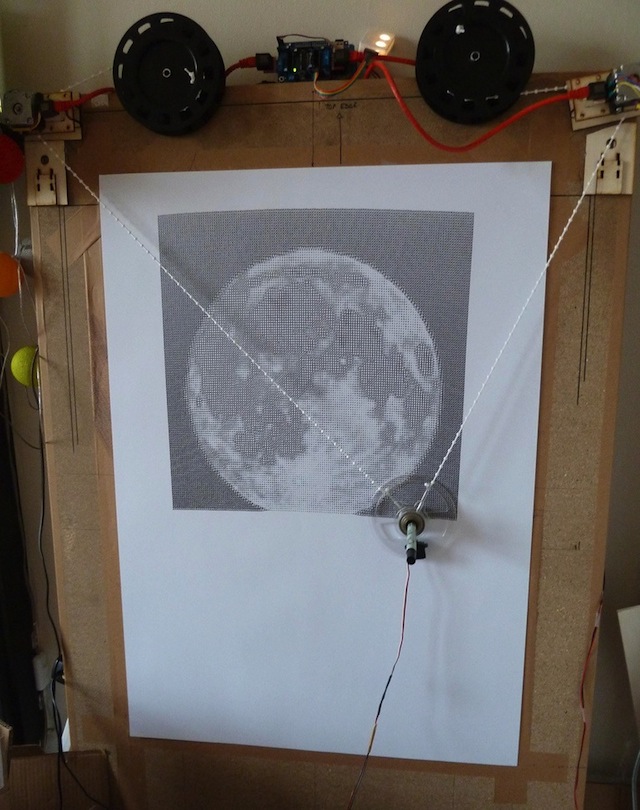
Sandy Noble
February 22/2012
If you had to describe your current self to a 16-year-old you, what would you say?
Just like you, but all the the things that made you a bit odd then, are the things that make me valuable now.
Could you describe an evolution in your work or way of thinking?
I’m very attached to how things work, rather than what they look like, or probably even what they do. When I was a kid I made lots of plastic models, and enjoyed making some much more than others. Some kits assembled beautifully, with lots of sub-assemblies, tabs, interlocking pieces. Others left much more up to the builder’s skill to judge where a part should be stuck. I never painted them – that’s the boring bit – where’s the fun?
I’m still very technically-focused, and working on projects where I am the designer and also the implementer suits that focus, it’s absolutely appropriate. But it can be a handicap in the ideation phase of a project so I needed to learn to know when to switch it off. Learning about the stagey, iterative nature of the design process taught me when I should be thinking technically and when I should be thinking free-form.
I’m not very good at the free-form stuff, that’s the problem, and it’s partly a skills issue – I just never got very good at sketching fast, representation. Everything I do I tend to want to boil it down to a series of diagrams, and just hold the gestalt of it in my head. This skills problem really does flavour what I get around to doing – if it’s hard to express, it just doesn’t get done, or at least, it doesn’t get put down on paper. It just floats around in my head until it crystalizes enough to be diagrammed, and that’s unfortunately a good way to lose inspiration, and can be discouraging when I look in my sketchbook and see the same old thing page after page, rather than all the amazing ideas I think I’m having but can’t express very clearly.
Generally my work is very tools-led. I like using the tools much more than I like having the finished object. Design is nice because design itself is a great big tool that can be used to make anything. So I made a desk once, and it works great as a desk, but my favourite thing about it is the work I did designing it.
So my art is entirely a product of the machine – the machine is the real piece of work, the drawings that come from it are only the proofs. The polargraph machine is interesting too because it’s very very technical. It’s programmed with a certain behaviour, and that’s where I see the art in it, that’s where the magic is. Which is nice, because as a professional software developer, it’s the exact same art that I use during my day job.
Are there any people who have been instrumental in the development of your way of thinking and viewing the world?
Other than my immediate family, very few. My mom and dad are very practical people who would be happy to fix and make things from scratch. They tell me “I’ll show you how, then you can do it yourself” and in many cases this the result of being tired of endlessly doing stuff for other people, but in other cases it is a genuine wish to share something they find marvelous and engaging. Their house has a gate at the back with this carved wooden handle on the back, just a plain one, functional. And it’d been carved and polished up and sat there every day for forty years. I remember being amazed and proud when only fairly recently I realized my dad had made it from a block of wood rather than just buying one from a shop. It was clearly the product of some love, some enjoyment of the process. Because actually it was pretty unnecessary in that place. I was horrified when they threw that door away to get a new one, handle and all, all replaced by off-the-shelf hardware. They are very unsentimental like that.
I suppose I am too, which is why I don’t like things which are purely decorative. Even if a photograph or a painting looks beautiful, I’m more interested in knowing what technical aspects create that feeling, or how it was made than just letting it wash over me, and if I don’t know that, I can’t really decide if I like it or not.
How do your political beliefs inform or fuel your work as an artist?
I feel that if people take from others, they should give to others. And, paying forward rather than paying back. People would like me to claim that I invented the polargraph machine, or that I am a trail blazer of some sort for using 3d printing in jewellry, and are a little dismayed when I tell them these things are just the most recent development of very commonplace technology – there is no high-tech here, no genius, no special insight, only the will to experiment for it’s own sake, and the will to publicly invest in something. That in itself, like art, is quite attractive and will get people’s attention.
So even though I’m a little wary of just giving all my hard work away, I realize I must because I owe it. This is especially true in areas with a strong community, learning aspect, that is, open source software and hardware, and the people who made that possible. It feels very wrong to take something that is free, bottle it and try to sell it back.
What do you feel a city should be or do for its inhabitants?
A city should be present enough to lead people into a community, but get out of the way enough to allow people to shape it, splinter it, build individual identities within it. Easier said than done.
Hi, 5 with David Spriggs
About the Hi, 5 Interview Series
Hi, 5 (5 Questions) is a web-only interview series which presents five questions to artists, activists, and creative thinkers alike. The project acts as an educational device which allows us to gain insight into the narratives that define successful individuals. We are interested in the motivations behind ambitious ideas and how these individuals chart personal change in relation to their surroundings.
About David Spriggs
David Spriggs explores the representation and strategies of power, the symbolic meanings of colour, and the thresholds of form and perception. His installation based work lies in a space between the 2 and 3 dimensions. In many installations he uses a technique he developed in 1999 using multiple painted layered images in space to create unique ephemeral like forms. The subjects depicted in his work relate to the breakdown and recreation of form and volume – as seen through his interest in cyclones, explosions, and forces.
David Spriggs is currently based in Montreal. He was born in 1978 in Manchester, England, and immigrated to Canada in 1992. He received his Master of Fine Arts from Concordia University, Montreal, and his Bachelor of Fine Arts from Emily Carr University in Vancouver.
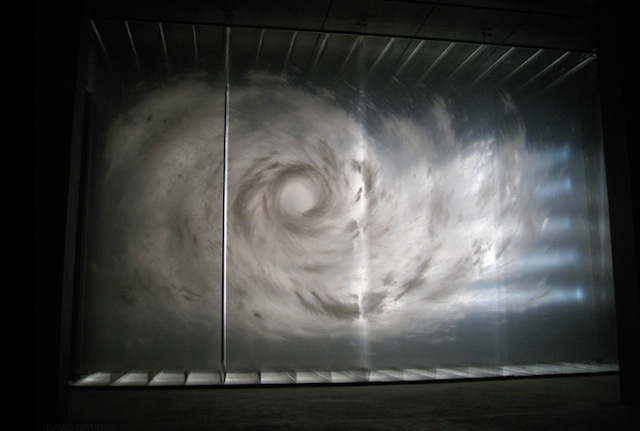
David Spriggs
February 19/2012
If you had to describe your current self to a 16-year-old you, what would you say?
I am a contemporary artist working primarily on installation based work.
Could you describe an evolution in your work or way of thinking?
I have been through many different styles in my life as an artist. I tried everything to find out what works and what doesn’t. My thinking has lead from concept to another. 12 years ago I started thinking about transparency, then about 8 years ago concepts around the immaterial and perception, and more recently on concepts of power and the symbolic notions of colour.
Are there any people who have been instrumental in the development of your way of thinking and viewing the world?
The theories of the Futurists and Cubists have been interesting to me. I have been perhaps most inspired by writers such as Baudrillard, Virilio, and Foucault.
How do your political beliefs inform or fuel your work as an artist?
I would say that it is not so much political beliefs as much as being informed about the world, the general news, and advancements in science and theory.
What do you feel a city should be or do for its inhabitants?
A city is a changing organism that keeps it’s community alive. I would like to think culturally that a city provides its citizens a network in which the arts can flourish.
Hi, 5 with Alex Asher Daniel
About the Hi, 5 Interview Series
Hi, 5 (5 Questions) is a web-only interview series which presents five questions to artists, activists, and creative thinkers alike. The project acts as an educational device which allows us to gain insight into the narratives that define successful individuals. We are interested in the motivations behind ambitious ideas and how change has been affected by those with the passion for progress in their practice.
About Alex Asher Daniel
Alex Asher Daniel is an American painter residing in New York City. Alex has a show of portraits coming up in March 2012 at the National Black Theatre in Harlem.
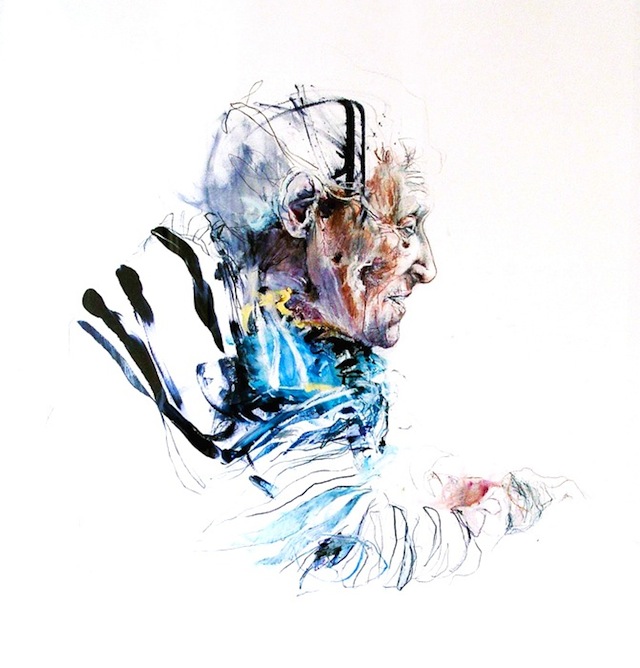
Alex Asher Daniel
February 1st/2012
If you had to describe your current self to a 16-year-old you, what would you say?
I still feel 16 at times, just with more battle scars. In many ways I am trying to reach back and find where I was as a child. There is a pure love of art and music when you are young, really letting it embrace you, an enchantment. I want the feeling again of loving a band and their music, before you actually met them and it ruined everything.
Could you describe an evolution in your work or way of thinking?
The work can not help but evolve if it is coming from a truthful place, because you yourself are ever changing. Even when I have made a point to work in a uniform series- each time I begin a new painting I feel as though I have never painted before. I have found myself consistently drawn to certain subject matter, but the approach to how I paint it is always changing. In my early work I was inspired by the figure, but I was intrigued by the shape of letters, numbers and blocks of colour. I incorporated that into my work, and it came across very graphic and two-dimensional. Today, I still explore the human body, but I am searching for meaning within the unseen space around my subject- it makes for a much more multidimensional experience.
Are there any people who have been instrumental in the development of your way of thinking and viewing the world?
That’s a big question. Off the top of my head… Of course, a great influence early on were my parents and their sensitivity for the arts and music, and their awareness of the human dynamic. The places I grew up in my youth, and the communities that surrounded me, especially the bay area and it’s social and spiritual consciousness.
The poet, Michael McClure, who was my English teacher in college, encouraged me to continue my studies in mysticism and the esoteric, both of which have been great influences on my work. There was a book I read when I was younger, an analysis of John Coltrane’s music by Bill Cole, which was a great inspiration at the time. My friendship with Caetano Veloso, who has such a beautiful heart, inspired me to have a more delicate approach to being. Around the time I first arrived in New York City, I met the designer Bill Katz. Bill let me use his studio, which is where I did my first series of portraits, so that was an important time for me. He also introduced me to my favorite scotch. There are so many more… but I will spare you.
How do your political beliefs inform or fuel your work as an artist?
I grew up in an environment surrounded by activism, and I feel that when done intelligently, the arts are the most powerful means of expression and education. I, however, am drawn to more ethereal explorations, so at times I was concerned with whether I should speak out more in my work, but then I realized that our works’ existence alone is revolutionary.
What do you feel a city should be or do for its inhabitants?
A city does nothing for its inhabitants but exist as a blank canvas for what you can manifest. Participate.

